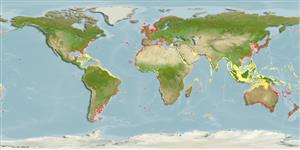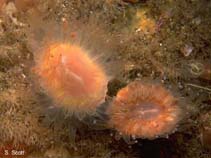Caryophyllia smithii Stokes & Broderip, 1828
Devonshire cup coral| Native range | All suitable habitat | Point map | Year 2050 |

|
| This map was computer-generated and has not yet been reviewed. |
| Caryophyllia smithii AquaMaps Data sources: GBIF OBIS |
Classification / Names Common names | Synonyms | CoL | ITIS | WoRMS
Anthozoa | Scleractinia | Caryophylliidae
Environment: milieu / climate zone / depth range / distribution range Ecology
Reef-associated. Subtropical
Distribution Countries | FAO areas | Ecosystems | Occurrences | Introductions
Atlantic Ocean, the Mediterranean and Indo-West Pacific.
Length at first maturity / Size / Weight / Age
Maturity: Lm ? range ? - ? cm
Short description Morphology
The stony corals non colonial, whose skeleton limestone reaches 0.35 cm vertically, of oval section, at base little, even hardly narrowed. The tentacles comprise at their end a small spherical bludgeon. Polyps: brownish coupler, brownish or pink, the generally ringed oral disc of a brown ring, drawing towards the red (Ref. 358).
Epibenthic (Ref. 87524). Polyps establish in excavations and cracks, at lower levels of rock overhangs and on rock faces, at depths greater than 10 m; seldom in shallow waters (Ref. 358). Occurs along the infralittoral, circalittoral and bathyal zones (Ref. 85338). Found throughout the Mediterranean. Associated with the barnacle Pyrgoma anglicum, as symphoriontes (Ref. 358).
Life cycle and mating behavior Maturity | Reproduction | Spawning | Eggs | Fecundity | Larvae
This species is viviparous, the fecundation of the ovum taking place inside the body of the parent, where they develop to with it until the stage of polyps in miniature (Ref. 358).
Main reference
References | Coordinator | Collaborators
Göthel, H. 1992. (Ref. 358)
IUCN Red List Status (Ref. 130435)
CITES status (Ref. 108899)
Appendix II: International trade monitored
CMS (Ref. 116361)
Not Evaluated
Threat to humans
Human uses
| FishSource |
Tools
More information
Internet sources
BHL | BOLD Systems | CISTI | DiscoverLife | FAO(Publication : search) | Fishipedia | GenBank (genome, nucleotide) | GloBI | Gomexsi | Google Books | Google Scholar | Google | PubMed | Hexacorallians of the World | Tree of Life | Wikipedia (Go, Search) | Zoological Record
Estimates based on models
Preferred temperature
(Ref. 115969): 8.9 - 21.3, mean 13.5 (based on 812 cells).
Price category
(Ref. 80766):
Unknown.



